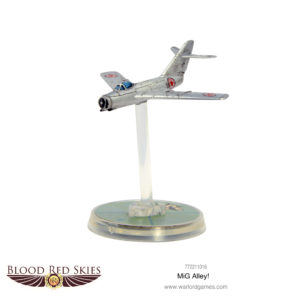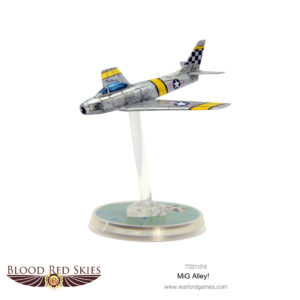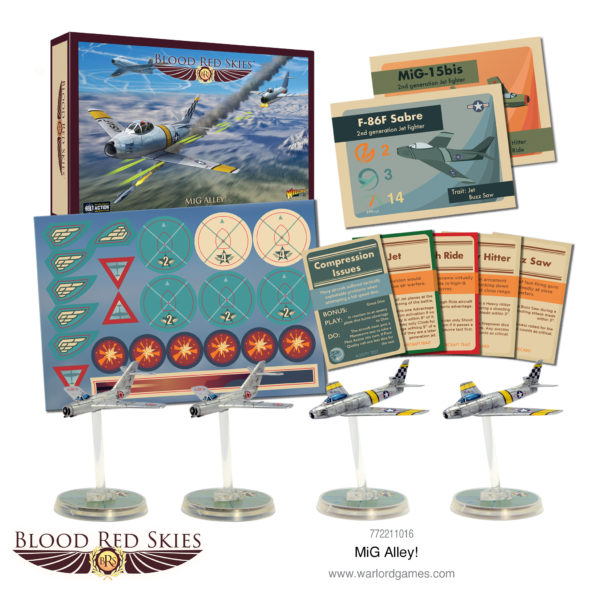
Spotlight: Enter the Jet Age
This week, we’re soaring down MiG alley as aerial warfare enters a new age! Grab your flight stick and enter the jet age!
MiG Alley shifts us into the future, moving away from the relatively sluggish prop-driven aircraft of World War 2 towards the shrieking jet aircraft of the Cold War! We’re looking at the two aircraft featured in the box, but keep an eye out for more jets on the horizon!
The Jet Age in Blood Red Skies
To represent the technological leap forward that occurred between the end of World War 2 and the start of the Korean War, we’ve introduced a new aircraft trait: Jet.
The jet trait allows an aircraft to immediately gain an advantage level on being activated. It cannot benefit from this ability if another jet is within 9″. This effectively gives jet aircraft a free use of dive or maneuver. Combined with their high speed, diving jets can rocket back and forth across the table, using long slashing passes to engage their opponents before moving out of danger.
Prop planes can’t climb for advantage within 9″ of a jet, but they may be able to outturn a jet with their much lower minimum move.
The MiG-15

Unlike the western allies, the Soviet Union did not have a domestic jet fighter program during the Second World War.
What it did have was a huge amount of the research and development completed by Nazi Germany, which was used to produce the MiG-9 – an unexceptional first-generation jet using reverse-engineered BMW jet engines.
Despite Stalin’s reservations, the Soviet Union acquired 25 Rolls Royce Nene jet engines, which when combined with the research on swept-wing aircraft obtained from the Germans, produced the MiG-15
Armed with a pair of 23mm cannons and a single 37mm cannon in the nose, it proved to be a fantastic interceptor, able to shred enemy aircraft with a blizzard of high explosive shells. An interesting quirk of this pairing was that the two calibres had vastly different velocities, providing the unnerving experience of the faster 23mm shells passing over an aircraft, while the 37mm would pass under.
The MiG-15 was widely exported to Soviet client states and first saw service during the Korean War, where it completely outclassed the P-80 Shooting Stars and Gloster Meteors – eventually meeting its match when the F-86 Sabres joined the battle.
The F-86 Sabre
By 1951, the US domestic fighter jet program had already turned out some middling straight-wing designs – universally plagued with mechanical faults and reliability issues.
While the P-80 Shooting Star and F-84 Thunderjet were sufficient for ground attack work, they were unable to stand up to the lightning-fast MiG-15s.
The F-86 Sabre was the first aircraft to benefit from Operation Paperclip – a program employing German scientists to further develop the projects they’d worked on under Hitler’s regime. Along with jet engines and aircraft, it also continued the German’s ballistic missile program – resulting in the American space vehicles and nuclear missiles.
Early F-86s were still unable to match the MiG-15 pound-for-pound. They could potentially out-dive them, but they could still be outmaneuvered. The upgraded F-model closed the gap and allowed the US to dominate the skies over the Korean battlefields.
MiG Alley
Join the battle for air superiority over Korean and grab your MiG Alley set today!
The post Spotlight: Enter the Jet Age appeared first on Warlord Games.


